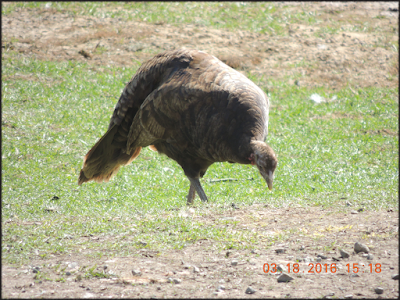First of all I had no idea how much ducks love grass...tall grass, short grass, fresh grass, old grass, green grass, dead grass....just as long as its grass! They still come in at night but also sleep out in the pasture. As the grass grows it gets harder to see them.
They always seem to have at least one lookout who keeps his head above grass and an eye to the sky! (There are about 10 ducks in this photo!) Next to grass ducks like dirt, fresh dirt is best, newly plowed or tilled and they are a real help...just ask Ralph!
I say "Cry Havoc and loose the ducks of War!"
We did not originally buy a roto tiller attachment for the Grillo but decided to after some problems with the 1984 Troy-built. It was not as expensive as we thought and it working out well. Ralph had already got the Hiller/furrower.
Grillo G110 Diesel with 30" tiller attachment
The Hiller/furrower for the Grillo
Tilling the new garden area
The new furrows.
The poultry liked the new turned dirt, bugs and grass shoots to nibble on! They all get along quite well. They also all seem to like different things.
The guineas are dangerous and totally oblivious to the Grillo, they will dig and peck in front of it right to the last second before Ralph would have to stop, then they run like crazy and complain as loudly as they can!
When Ralph plowed the sod the ducks found the edge of the plowing addicting and foraged up and back as Ralph worked. They did not get in his way but after about 10 trips back and forth they were so full they waddled out of the plowing to the edge of the grass and plopped down, stuffed and tired. Their crops almost dragged on the ground. We are not sure what they were eating...they were busy though and quite happy with something in the field.
The potatoes, Fava Beans, beets and peas are in the ground and the Garlic is showing up in full force in the section of the house garden we planted it in last fall. The Lilac bush is blooming but looks sickly so I am researching what it needs and our mystery bush that bloomed in December and withstood hard frost is blooming again.
The Mystery Bush...it looked like this in December too.
One of our young Buff Roosters, we kept two, has fallen hard for two flirtatious Buckeye hens...he takes very good care of them!
And then there are the turkeys..wild turkeys everywhere....HEY wait....thats not a wild turkey Tom thats our Bad boy Double Chocolate! He is still trying to win the hearts of the wild turkey hens! They just ignore him!
We are getting a lot done and have more to do, work is endless on a farm but so worth it. We go to sleep at night planning the next days adventures and there is always something new to see and do. Life is wonderful!
God Bless all of you and keep safe.....enjoy life like this Buckeye hen, she is loving the spring dining!



















































